Assessment of Surface Water Resources of Eastern Iraq
Abstract
1. Introduction
2. Materials and Methods
2.1. Study Area Description
2.2. Watershed Characteristics
2.3. Precipitation and Runoff Calculations
2.4. Data Analysis
3. Results
3.1. Predicted Versus Observed Runoffs
3.2. Water Harvesting Techniques and Proposed Reservoir
4. Discussion
5. Conclusions
Author Contributions
Funding
Acknowledgments
Conflicts of Interest
References
- Population and Water Resources. Available online: https://www.un.org/popin/fao/water.html (accessed on 8 June 2019).
- Rahi, K.A.; Halihan, T. Changes in the salinity of the Euphrates River system in Iraq. Reg. Environ. Chang. 2010, 10, 27–35. [Google Scholar] [CrossRef]
- Rahi, K.A.; Halihan, T. Salinity evolution of the Tigris River. Reg. Environ. Chang. 2018, 18, 2117–2127. [Google Scholar] [CrossRef]
- Rahi, K.A. Salinity management in the Shatt Al-Arab River. Int. J. Eng. Technol. (Uae) 2018, 7, 128–133. [Google Scholar] [CrossRef]
- Critchley, W.; Siegert, K. Water Harvesting, 2nd ed.; Food and Agriculture Organization of the United Nations: Rome, Italy, 1991. [Google Scholar]
- Malik, M.I.; AL-Shammary, S.H.; AL-Hamzawy, H.M. Morphometric analysis of al-Chabab river basin east of Iraq using Remote Sensing and GIS techniques. Int. J. Sci. Eng. Res. 2014, 4, 2347–3878. [Google Scholar]
- Al-Hussaini, S.N.; Al-Obaidy, A.M.; Al-Mashhady, A.A. Environmental assessment of heavy metal pollution of Diyala River within Baghdad City. Appl. Water Sci. 2018, 8, 1–6. [Google Scholar] [CrossRef]
- Al-Sudani, H.Z. Study of morphometric properties and water balance using Thornthwaite method in Khanaqin basin, east of Iraq. J. Univ. Babylon Eng. Sci. 2018, 26, 165–175. [Google Scholar]
- Iraq meteorological organization and seismology. Available online: http://www.meteoseism.gov.iq (accessed on 20 March 2019).
- Jawad, T.K.; Al-Taai, O.T.; Al-timimi, Y.K. Evaluation of drought characteristics in Iraq using SC-PDSI. Sci. J. Univ. Zakho 2018, 6, 94–99. [Google Scholar] [CrossRef][Green Version]
- Zakaria, S.; Al-Ansari, N.; Kuntsson, S.; Ezz-Aldeen, M. Rain water harvesting and supplemental irrigation at northern Sinjar mountain, Iraq. J. PurityUtil. React. Environ. 2012, 6, 121–141. [Google Scholar]
- Hassan, M.A.; Selman, A.A.; Ghani, A.A. Morphometric properties of Bulkana (NaftKhanah) north-east Iraq from topographic maps. Int. J. Curr. Eng. Technol. 2014, 4, 45–51. [Google Scholar]
- Ali, R.; Ismael, A.; Heryansyah, A.; Nawazakaria, N. Long term historic changes in the flow of lesser Zab River, Iraq. Hydrology 2019, 6, 22. [Google Scholar] [CrossRef]
- Al-Mukhtar, M.; Al-Yaseenli, F. Modeling water quality parameters using data-driven models, a case study Abu-Ziriq marsh in south of Iraq. Hydrology 2019, 6, 24. [Google Scholar] [CrossRef]
- Awchi, T.A.; Kalyana, M.M. Meteorological drought analysis in northern Iraq using SPI and GIS. Sustain. Water Resour. Manag. 2017, 3, 451–463. [Google Scholar] [CrossRef]
- Ali, K.A. Geospatial hydrological analysis in GIS environment for selecting potential water harvest sites: The case of Badrah –Wasit. J. Univ. Babylon 2018, 26, 328–337. [Google Scholar] [CrossRef]
- Ibrahim, G.F.; Azad, A.R.; Hamid, A.A.; Ali, Z.F.; Dewana, A.A. Suitable site selection for rainwater harvesting and storage case study using Dohuk Governorate. Water 2019, 11, 864. [Google Scholar] [CrossRef]
- Ali, M.H. Transboundary waterways and streams along the Iraq-Iran border line the reality and the future. Master’s Thesis, University of Baghdad, Baghdad, Iraq, 2012. [Google Scholar]
- Al-Salihi, A.M.; Al-lami, A.M.; Altimimi, Y.K. Spatiotemporal analysis of annual and seasonal rainfall trends for Iraq. Al-Mustansiriyah J. Sci. 2014, 25, 153–168. [Google Scholar]
- Al-Madhhachi, A.T.; Al-Mussawy, H.A.; Basheer, M.I.; Abdul-Sahib, A.A. Quantifying Tigris riverbanks stability of southeast Baghdad city using BSTEM. Int. J. Hydrol. Sci. Technol. (In press). [CrossRef]
- Al-Shamaa, I.M.; Ali, B.M. Estimation of groundwater recharge in Badra-Jassan Basin using annual water surplus method. Iraqi J. Sci. 2012, 53, 107–112. [Google Scholar]
- World Weather Online. Available online: https://www.worldweatheronline.com (accessed on 20 March 2019).
- Jennings, M.E.; Thomas, W.O.; Riggs, H.C. Nationwide summary of U.S. Geological Survey Regional Regression Equations for Estimating Magnitude and Frequency of Floods for Ungaged Sites; USGS Water-Resources Investigations Report: Washington, VA, USA, 1994.
- Saleh, D.K. Stream Gage Descriptions and Streamflow Statistics for Sites in the Tigris River and Euphrates River Basins, Iraq; US Geological Survey: Reston, VA, USA, 2010. [Google Scholar]
- Hasan, M.B.; Al-Madhhachi, A.T. The Influence of Crude Oil on Mechanistic Detachment Rate Parameters. Geosciences 2018, 8, 332. [Google Scholar] [CrossRef]
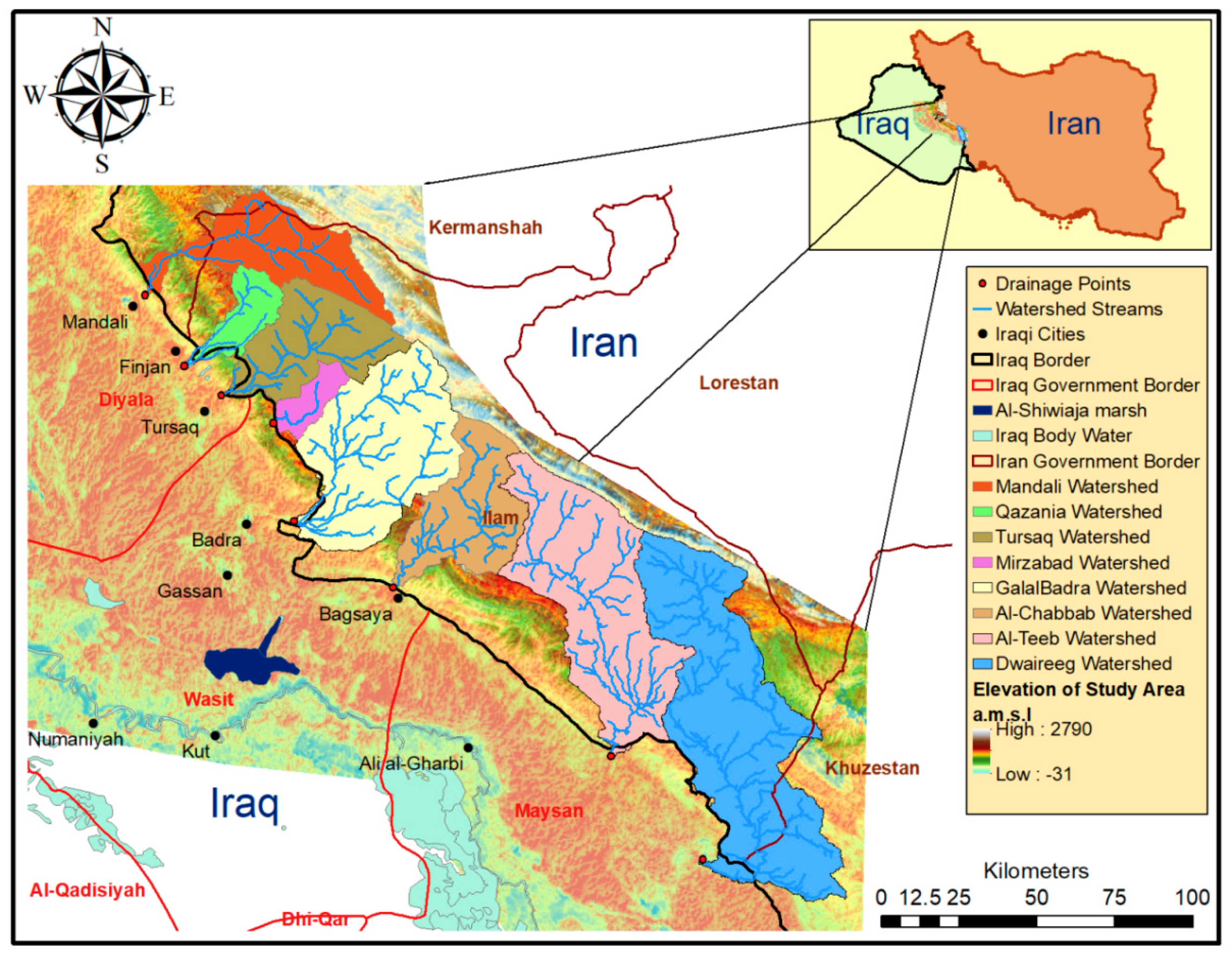
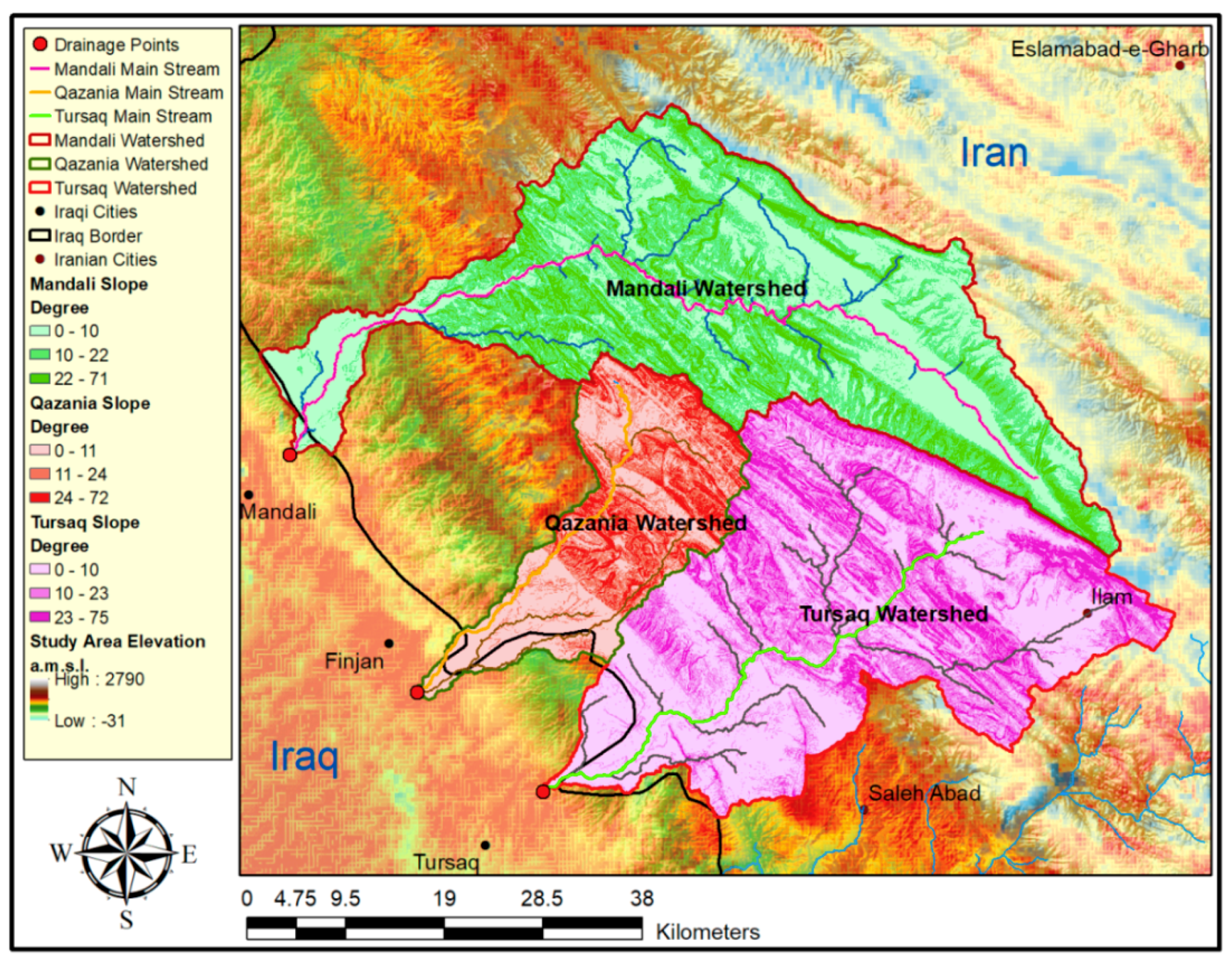
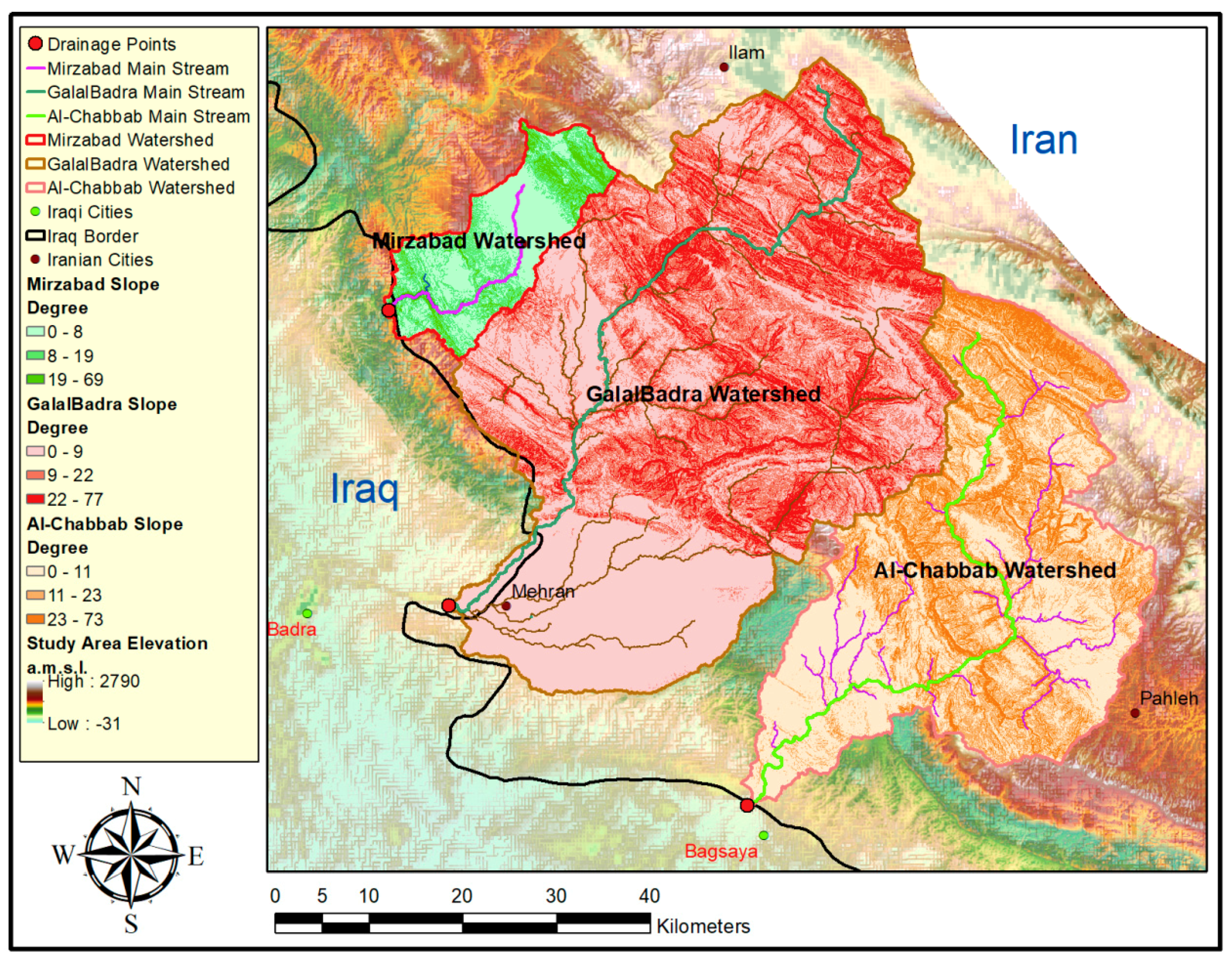
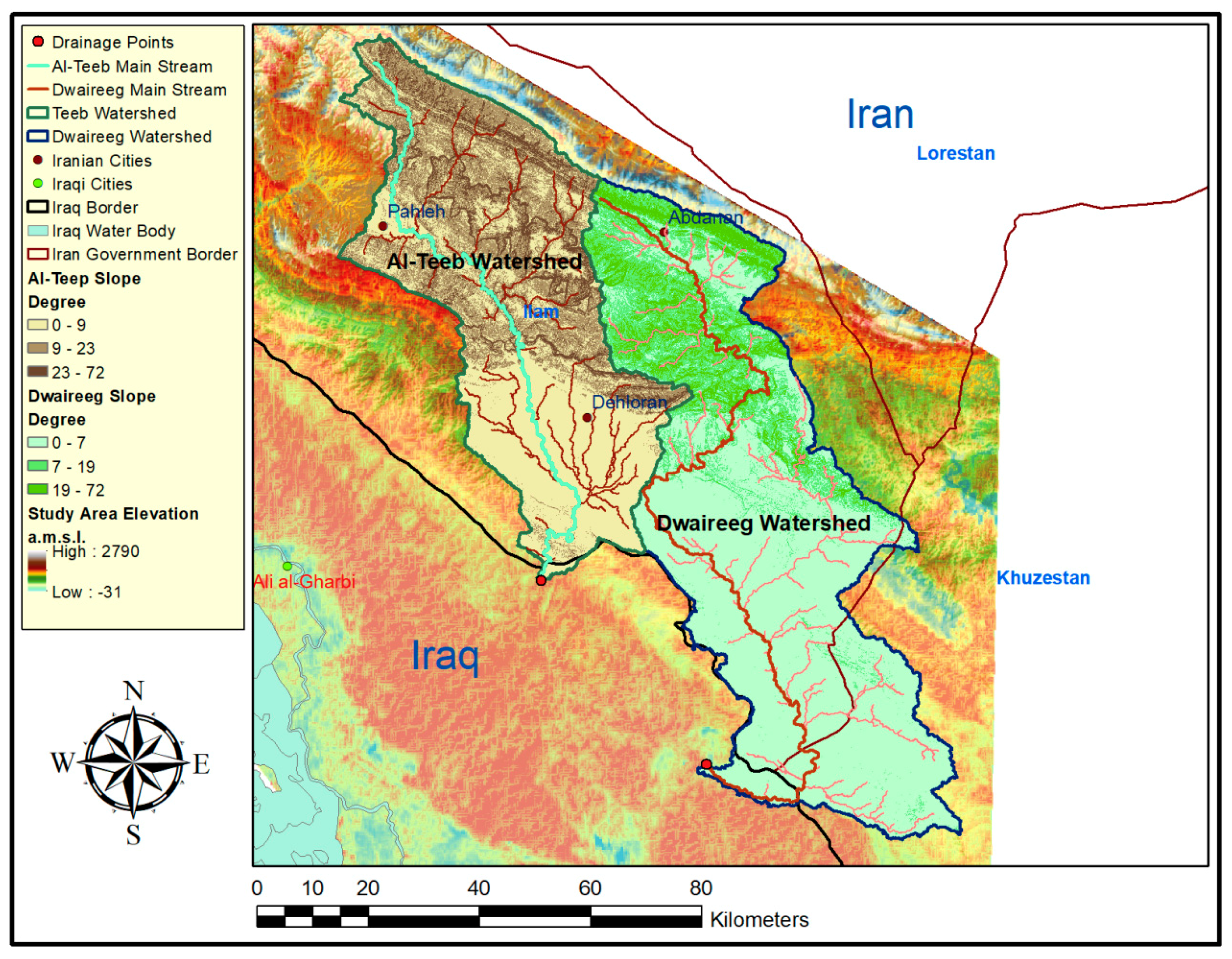
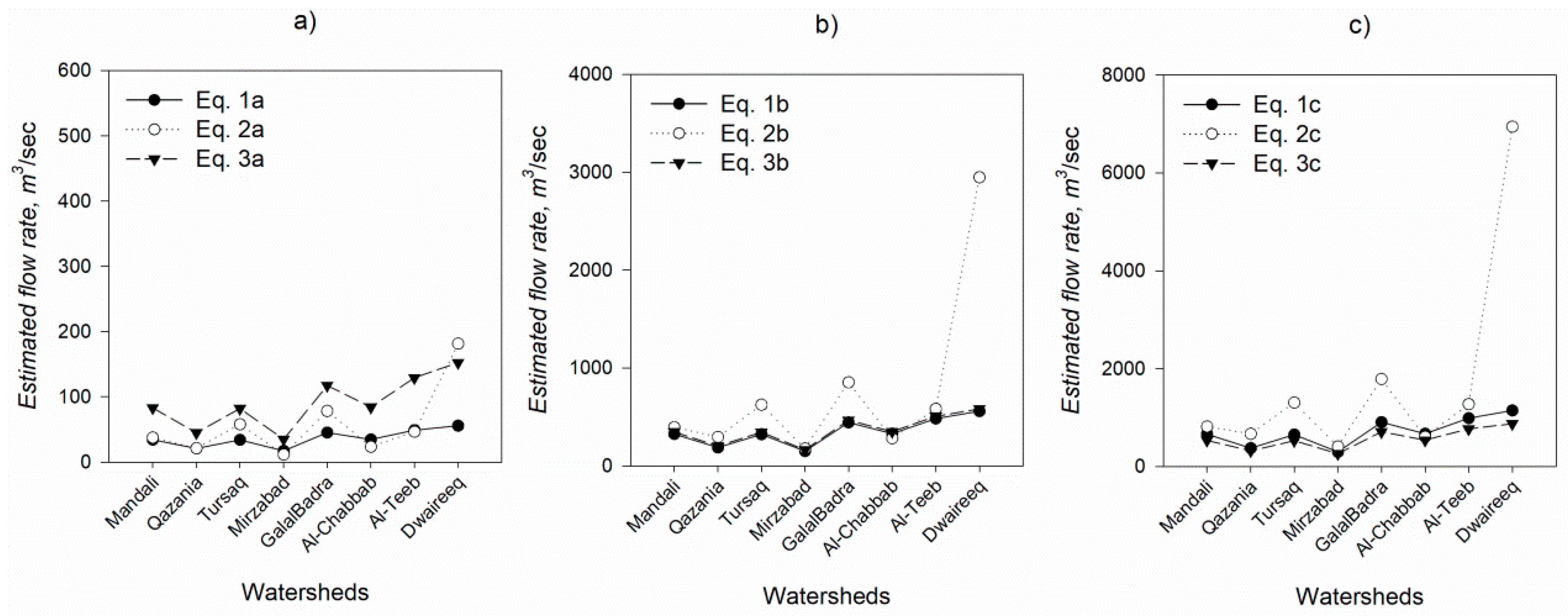
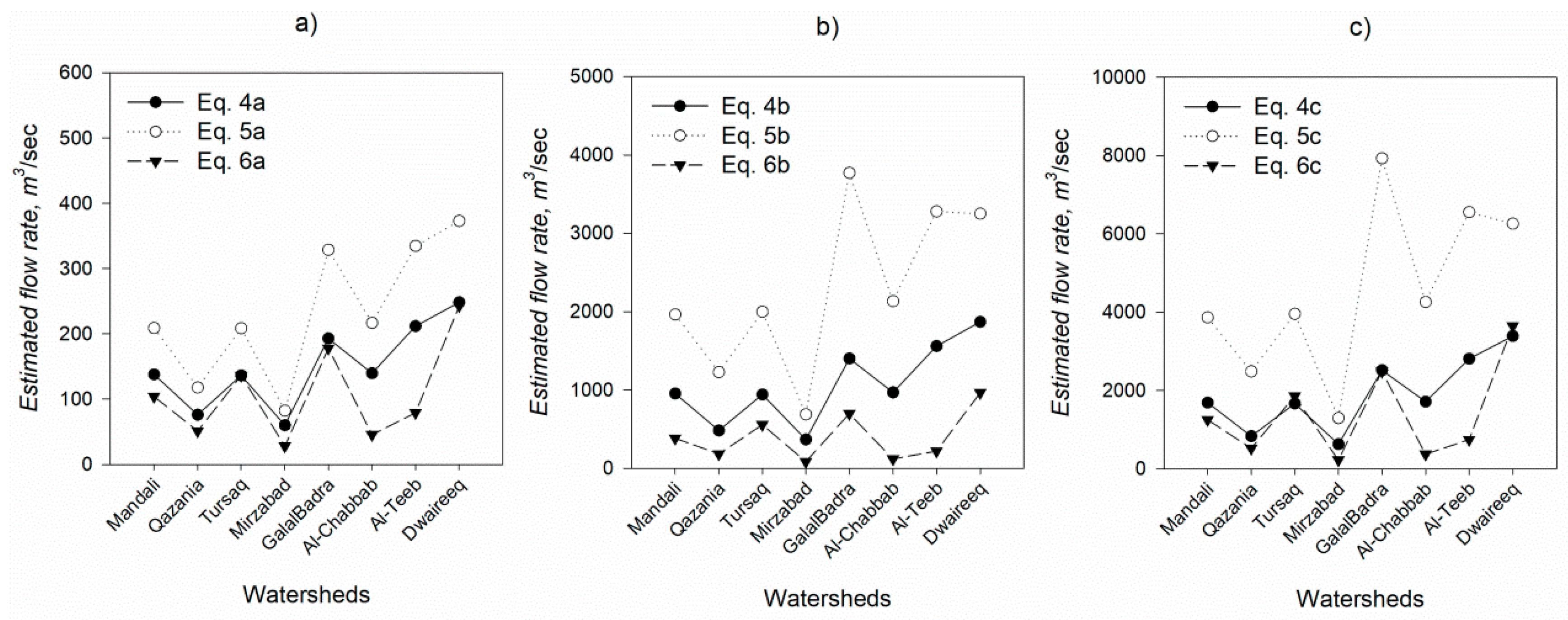
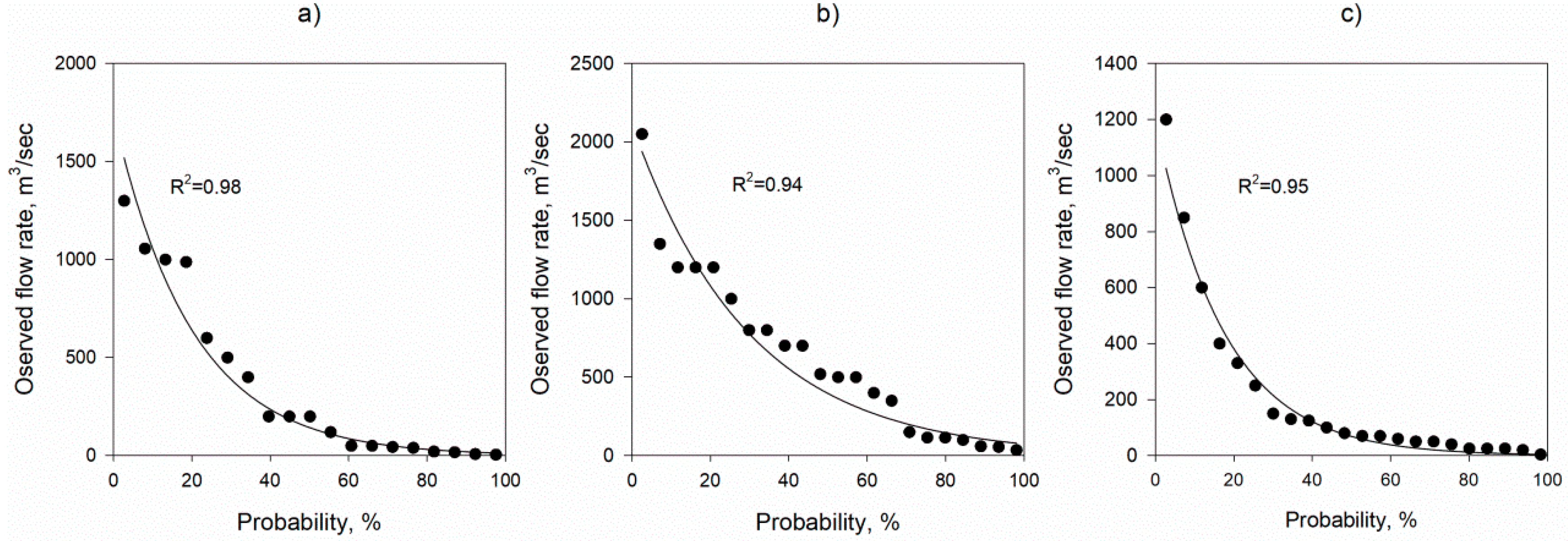
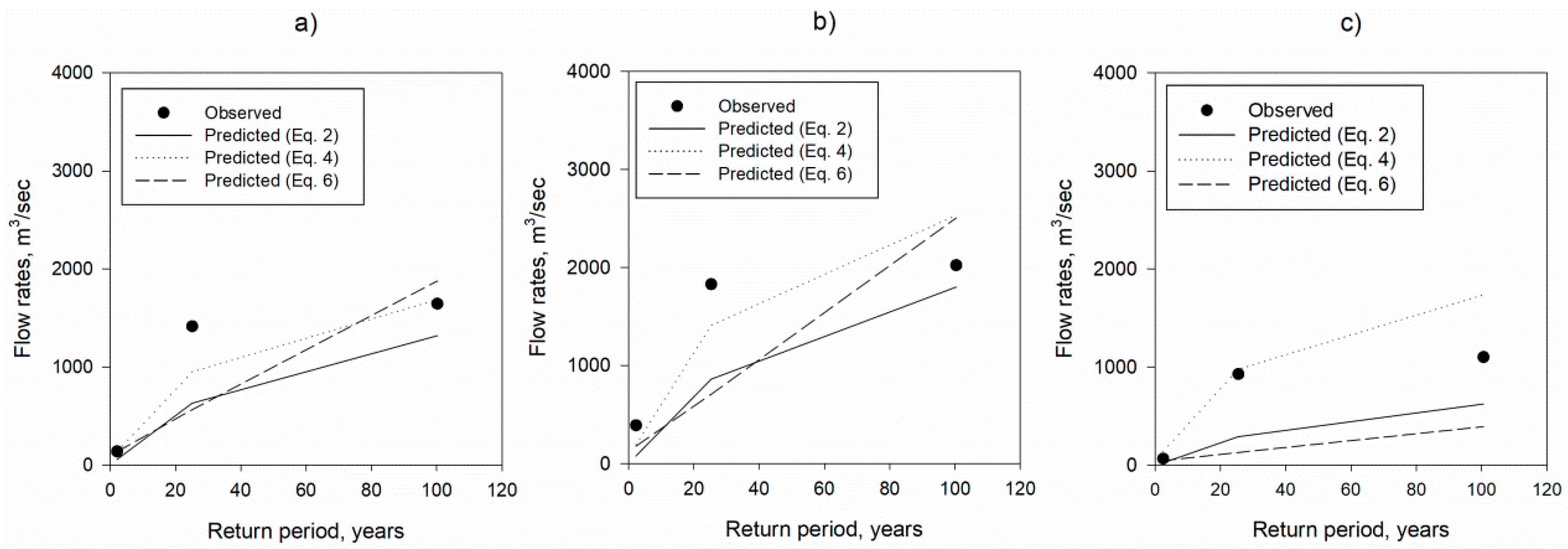
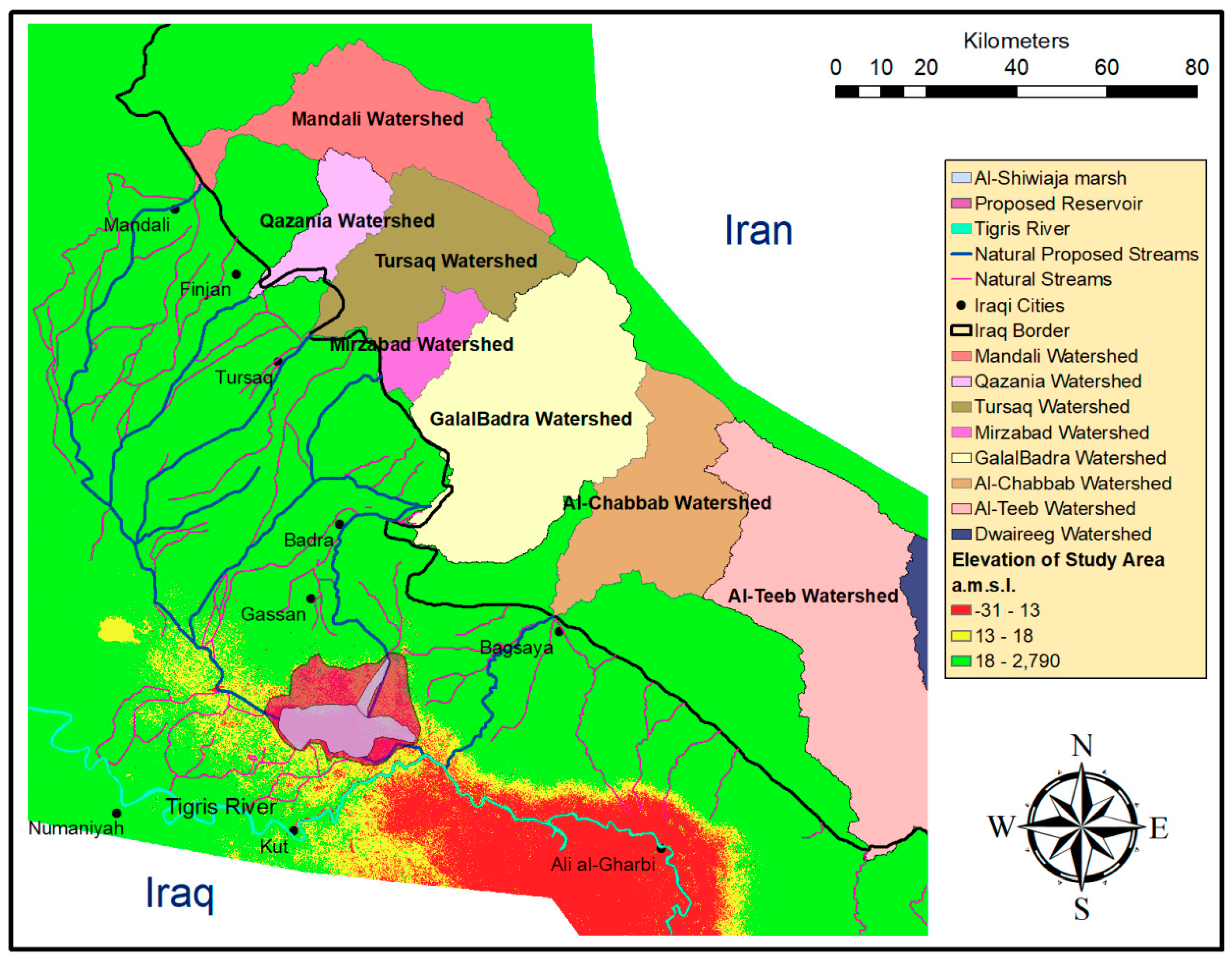
| Watershed Names | Drainage Outlet Coordinates, DMS | Average Terrain Slope, Degree | Catchment Area (A), km2 | Weighted Average of Terrain Elevation (E), m | Length of Main Stream, km | Main Stream Average slope (S), % |
|---|---|---|---|---|---|---|
| Mandali | 45°35′38″ E 33°46′52″ N | 12.56 | 1246.10 | 1101.26 | 106.98 | 0.011 |
| Qazania | 45°43′34″ E 33°34′26″ N | 13.77 | 419.75 | 746.71 | 42.51 | 0.027 |
| Tursaq | 45°51′18″ E 33°29′13″N | 12.50 | 1218.89 | 980.08 | 67.15 | 0.012 |
| Mirzabad | 46°01′59″ E 33°24′25″ N | 9.24 | 274.28 | 722.46 | 30.44 | 0.014 |
| Galal Badra | 46°05′56″ E 33°07′19″ N | 11.70 | 2306.09 | 929.01 | 95.32 | 0.018 |
| Al-Chabbab | 46°26′10″ E 32°55′34″ N | 13.38 | 1275.02 | 959.47 | 88.52 | 0.013 |
| Al-Teeb | 47°10′19″ E 32°25′48″ N | 11.25 | 2738.28 | 800.96 | 142.52 | 0.009 |
| Dwaireeg | 47°28′44″ E 32°7′34″ N | 6.36 | 3666.90 | 420.08 | 206.60 | 0.005 |
| Watershed Names | Mandali | Qazania | Tursaq | Mirzabad | Galal Badra | Al-Chabbab | Al-Teeb | Dwaireeg | |
|---|---|---|---|---|---|---|---|---|---|
| Annual Precipitation for different years, mm | 1995 | - | - | - | - | 345.0 | 109.0 | 198.0 | - |
| 1996 | - | - | - | - | 218.4 | 124.1 | 220.0 | - | |
| 1997 | - | - | - | - | 217.4 | 83.4 | 183.2 | - | |
| 1998 | - | - | - | - | 269.3 | 103.9 | 105.8 | - | |
| 1999 | - | - | - | - | 243.1 | 130.6 | 130.0 | - | |
| 2000 | - | - | - | - | 179.1 | 090.8 | 096.1 | - | |
| 2001 | - | - | - | - | 245.6 | 093.1 | 100.3 | - | |
| 2002 | - | - | - | - | 233.3 | 091.3 | 134.6 | - | |
| 2003 | - | - | - | - | 160.1 | 124.4 | - | - | |
| 2004 | - | - | - | - | 175.4 | 125.1 | - | - | |
| 2005 | - | - | - | - | 151.3 | 092.4 | - | - | |
| 2006 | - | - | - | - | 234.7 | 188.4 | - | - | |
| 2007 | - | - | - | - | 124.0 | 040.1 | - | - | |
| 2008 | - | - | - | - | 195.7 | 109.0 | - | - | |
| 2009 | 106.8 | 035.9 | 159.4 | 035.2 | 112.1 | 051.4 | 035.2 | 191.9 | |
| 2010 | 251.4 | 125.4 | 232.3 | 040.7 | 108.0 | 084.0 | 040.7 | 262.5 | |
| 2011 | 096.1 | 095.2 | 262.8 | 054.2 | 128.6 | 094.2 | 054.2 | 270.3 | |
| 2012 | 090.6 | 090.6 | 201.3 | 043.3 | 158.4 | 056.6 | 043.4 | 206.0 | |
| 2013 | 149.6 | 181.7 | 213.8 | 240.9 | 290.4 | 156.1 | 188.6 | 284.3 | |
| 2014 | 166.2 | 174.2 | 182.2 | 190.2 | 198.2 | 130.2 | 053.7 | 260.8 | |
| 2015 | 066.8 | 084.6 | 102.5 | 110.3 | 138.1 | 110.2 | 060.3 | 071.0 | |
| 2016 | 104.4 | 147.9 | 191.4 | 224.9 | 278.4 | 160.9 | 079.7 | 095.4 | |
| 2017 | 111.4 | 115.1 | 138.7 | 152.3 | 165.9 | 073.3 | 062.8 | 159.4 | |
| 2018 | 138.8 | 138.7 | 265.7 | 039.5 | 265.3 | 074.9 | 037.6 | 121.2 | |
| 2019 | 894.4 | 894.2 | 1142.1 | 451.7 | 1139.9 | 423.5 | 451.7 | 809.8 | |
| Average precipitation (P), mm | 197.9 | 189.4 | 281.1 | 143.9 | 239.0 | 116.8 | 119.8 | 248.4 | |
© 2019 by the authors. Licensee MDPI, Basel, Switzerland. This article is an open access article distributed under the terms and conditions of the Creative Commons Attribution (CC BY) license (http://creativecommons.org/licenses/by/4.0/).
Share and Cite
Rahi, K.A.; Al-Madhhachi, A.-S.T.; Al-Hussaini, S.N. Assessment of Surface Water Resources of Eastern Iraq. Hydrology 2019, 6, 57. https://doi.org/10.3390/hydrology6030057
Rahi KA, Al-Madhhachi A-ST, Al-Hussaini SN. Assessment of Surface Water Resources of Eastern Iraq. Hydrology. 2019; 6(3):57. https://doi.org/10.3390/hydrology6030057
Chicago/Turabian StyleRahi, Khayyun A., Abdul-Sahib T. Al-Madhhachi, and Safaa N. Al-Hussaini. 2019. "Assessment of Surface Water Resources of Eastern Iraq" Hydrology 6, no. 3: 57. https://doi.org/10.3390/hydrology6030057
APA StyleRahi, K. A., Al-Madhhachi, A.-S. T., & Al-Hussaini, S. N. (2019). Assessment of Surface Water Resources of Eastern Iraq. Hydrology, 6(3), 57. https://doi.org/10.3390/hydrology6030057






